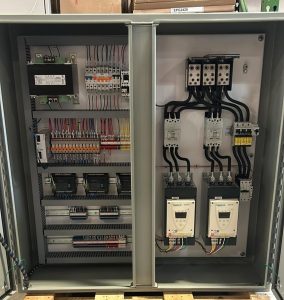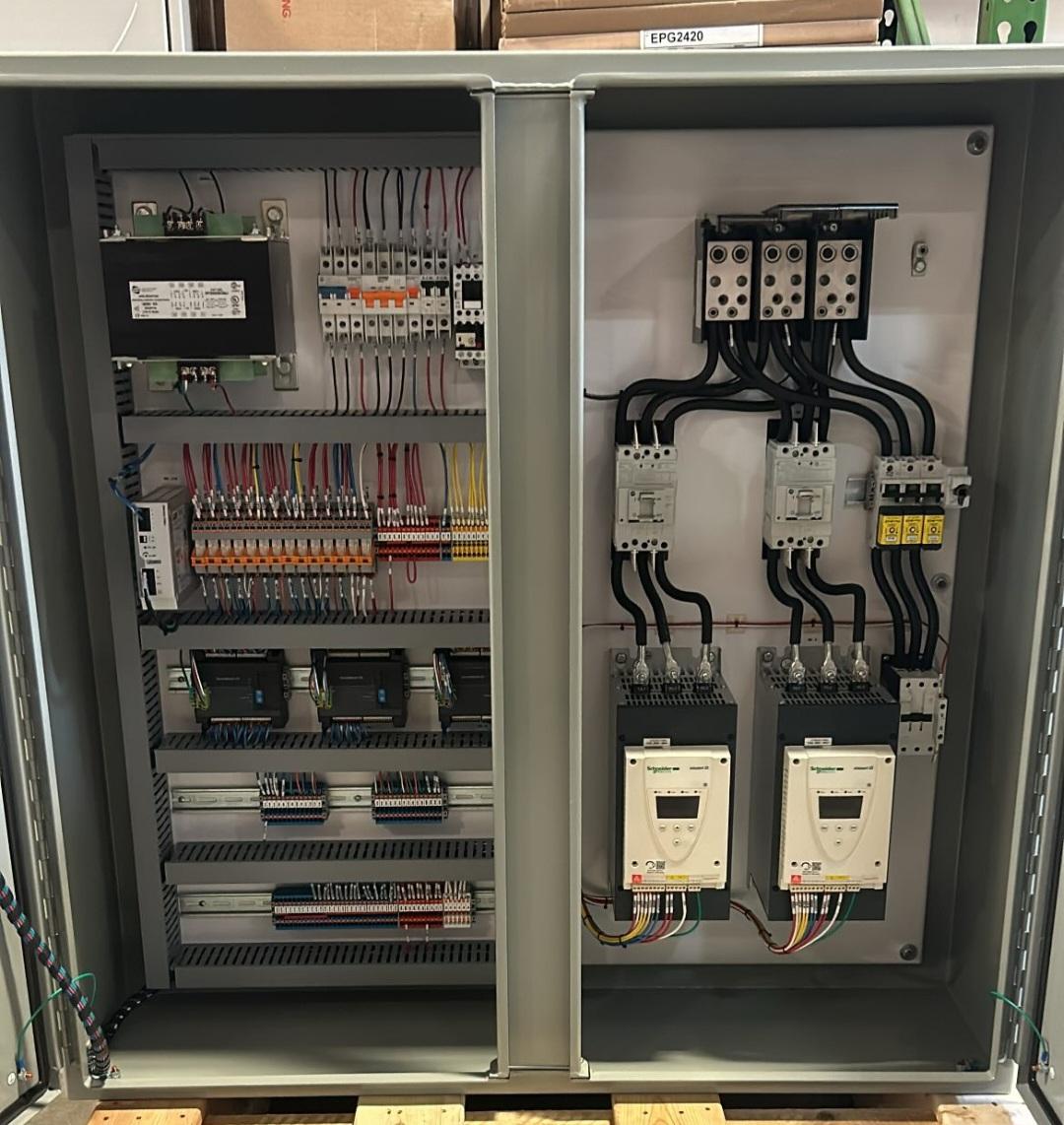What exactly is UL 508A? The term refers to a document that spells out standards and requirements for the fabrication of industrial control panels, authored by the global safety science and engineering organization Underwriter’s Laboratory (or UL). In this document, UL condenses its long history of extensive electrical safety testing into concise directions on fabricating industrial control panels according to national codes and UL’s best practices. Here at Sauer Compressors USA, all of our panels are UL 508A Listed, and our panel shop is UL 508A Certified. In this article, we’ll describe why you should choose a compressor partner offering UL 508A Certification, what this standard entails, and how you’ll benefit from UL listed control panels.
engineering organization Underwriter’s Laboratory (or UL). In this document, UL condenses its long history of extensive electrical safety testing into concise directions on fabricating industrial control panels according to national codes and UL’s best practices. Here at Sauer Compressors USA, all of our panels are UL 508A Listed, and our panel shop is UL 508A Certified. In this article, we’ll describe why you should choose a compressor partner offering UL 508A Certification, what this standard entails, and how you’ll benefit from UL listed control panels.
UL 508A Certification Overview
A control panel that is fabricated to UL 508A is referred to as a Listed panel and is allowed to have the UL mark applied to the panel. This mark communicates to regulators and end-users that the panel was fabricated safely, code-compliant, and professionally.
For a panel shop to be able to use the UL Listed mark, it has to be UL 508A Certified. A Certified shop earns this credential by having its work practices, documentation, and assembly environment audited and inspected by UL engineers, assuring that the shop can meet the quality and safety threshold expected to carry the UL mark. To maintain certification, the panel shop must be regularly audited by UL.
In practice, a UL Certified shop delivering UL Listed panels on a project is invaluable in assuring project safety and quality, especially on inspected projects. We’ll next take a look at these benefits in closer detail.
Benefits of UL Listed Panels
Why should customers prefer an air compressor manufacturer that offers UL 508A listed control panels in their packaged compressor systems over a non-certified manufacturer? Several reasons:
- Personnel Safety – all the components used in a UL listed panel are required to be lab tested for quality and safety, and arranged in a way that assures safe operation. Non-listed components or arrangements can have a higher risk of arc flash, heat accumulation that leads to fire, or electrocution when compared to listed components and arrangements.
- Regulatory Compliance – a control panel shop that is UL 508A certified is inherently required to comply with a host of standards and code requirements referenced within the standard. This code requires that panel shops and equipment builders also follow specific other Underwriter’s Laboratory (UL), National Electric Code (NEC), American National Standards Institute (ANSI), National Fire Protection Act (NFPA), and International Electrotechnical Commission (IEC) standards. The presence of the UL mark communicates to inspecting regulators that all of these codes are assuredly met.
- Design Confidence – a UL listed panel has been designed, tested, and inspected to meet the host of regulations mentioned above prior to the panel being delivered to the job site. This instills local field inspectors and end-users alike with the highest level of confidence that the panel is safe to operate. Further, local inspectors do not need to repeat detailed reviews or testing of the panel, knowing that the UL listing assures that this testing has already been performed. This often results in faster regulatory permit approvals.
- Panel Quality – the selection of components in a UL listed panel must be from recognized, high-quality, reputable manufacturers. These manufacturers are also frequently inspected and re-certified over time, as needed to maintain their UL mark. The UL mark conveys that not only the panel but all of its components as well are produced by recognized manufacturers to meet UL’s rigorous requirements.
UL 508A Panel Design Criteria
To dive a little deeper into the requirements of UL 508A, let’s examine several key criteria governed by the standard:
Components – device selection is a large part of UL 508A. UL writes standard documents for nearly every component found in industrial control panels, laying out strict limitations on what versions or styles of components can be used for specific functions.
For example, take the category of disconnect switches. Only certain Circuit Breakers or Disconnects specified in UL 489 and UL 98 respectively may be used as main panel disconnects, whereas UL 508 Motor Controller Disconnects may not be used in this position despite appearing to be very similar in design.
Circuit protection – stopping a short circuit, or more importantly, employee electrocution entirely relies on the proper and sufficient circuit protection devices installed in your system. Some circuit breakers and fuse holders may all appear similar but will have very different ratings, reaction times, sensitivities, and test procedures between them.
For example, a Supplementary Protector Circuit Breaker per UL 1077 is designed to protect equipment up to 100% of its rated current, whereas a Molded Circuit Breaker per UL 489 is more intended to protect against fires and overloaded wiring up to 80% of its rated current.
Spacing – electrical components that end up too close together can generate and transfer heat between them, or worse, arc electricity over or through components entirely. Electricity can “jump” between points on a single device, to other nearby grounded components, and even to a person’s hand without direct contact. UL 508A governs spacing of component features, separation of dissimilar voltages, separation of conductor insulation ratings, finger safety requirements around service points, and more.
A good example of where spacing really matters is around the wiring lugs for circuit breakers. UL 489 circuit breakers are used for branch circuit protection and have large space requirements between components. A lower tier of circuit protection is found in UL 1077 supplementary protectors, which are used to protect individual circuits within equipment and have smaller space requirements between components.
Adherence to local/regional electrical codes – UL 508A references and reinforces standards found in NFPA 70 / National Electric Code, NFPA 79 (IEC 60204) / Electrical Standard for Industrial Machinery. Panel designers and builders must be sure to check all of these codes and integrate their requirements, in order to maintain their UL certification.
Labeling and identification – labeling is a large part of UL 508A for both safety and compliance purposes. UL marks are not only found on overall panels but on any and all individual components in the panel as well (that is, on the components that are required to be marked). At the component level, the UL label communicates key information about how that component is to be installed and operated in order for it to maintain its designed safety and performance.
For example, using a 24VDC Class 2 field sensor requires that it be connected to a Class 2 power supply circuit. If the sensor is installed without a UL listed Class 2 power supply, then the sensor immediately loses its Class 2 rating, introducing safety and functional risk.
In some cases, a generic UL marked device might make its way into an application or function that it is not designed to handle. The presence of a UL mark doesn’t necessarily mean a component can do any potential job in a panel. For instance, a power supply that is UL 508 listed may be applied at 100% of its amp rating, whereas a power supply listed to a different UL standard (or not listed at all) may only be applied at 50% of its amp rating. UL 508A requires that components be placed explicated into the application or function that they are designed to handle, and as such, the UL mark on your control panel assures that the panel builder took this into consideration.
One more important detail on labeling: not all markings are created equal. In some cases, generic labels on devices might make the component appear to be a regulated and properly placed component. A common misconception is seeing a “CE” mark on certain parts and thinking those to be UL equivalent, though this is quite incorrect – this CE mark is a non-technical label, only denoting a Chinese-manufactured component for export. UL 508A rigorously controls which labeling is permissible to accept in a UL listed panel.
Finally, UL listing also governs the installation means for listed components. For example, certain UL listed cables, wires, components (lugs/termination ends), and fittings, all require the use of a specific tool and procedure in order to ensure the safety and reliability of the component. For a panel to be UL listed, the panel builder must use both the listed component as well as the prescribed tool and procedure.
When choosing your compressed air or gas system, be sure to consider the above benefits of UL 508A listed panels, devices, and installation methods. Sauer Compressors USA delivers these benefits as our standard offering, giving our customers yet another point of confidence in our packaged systems. To learn more about our industry-leading solutions, call (410) 604-3142 or email [email protected].

You must be logged in to post a comment.